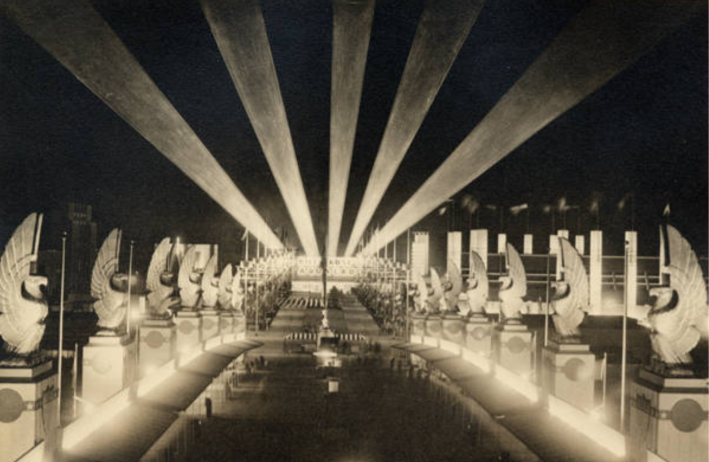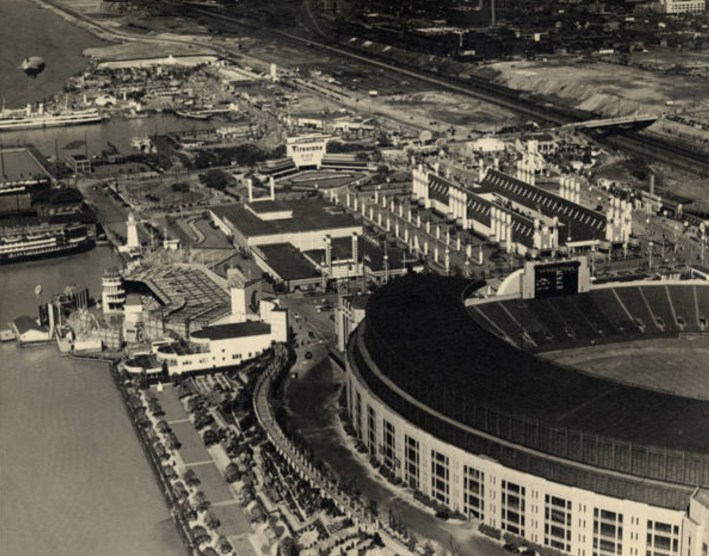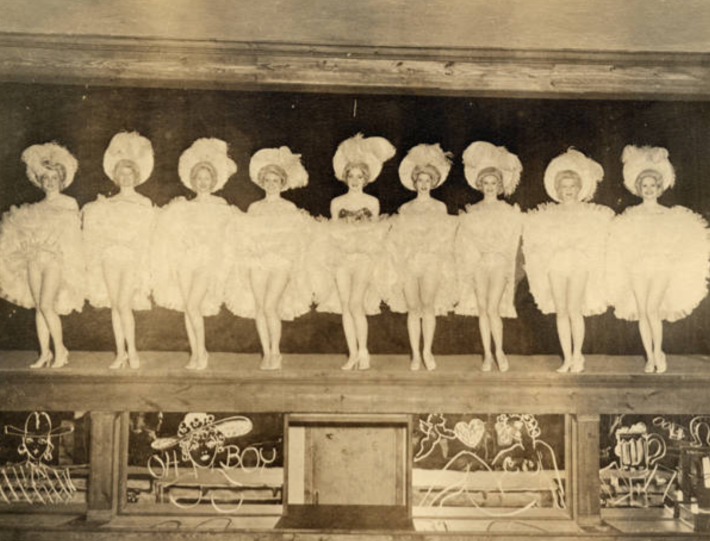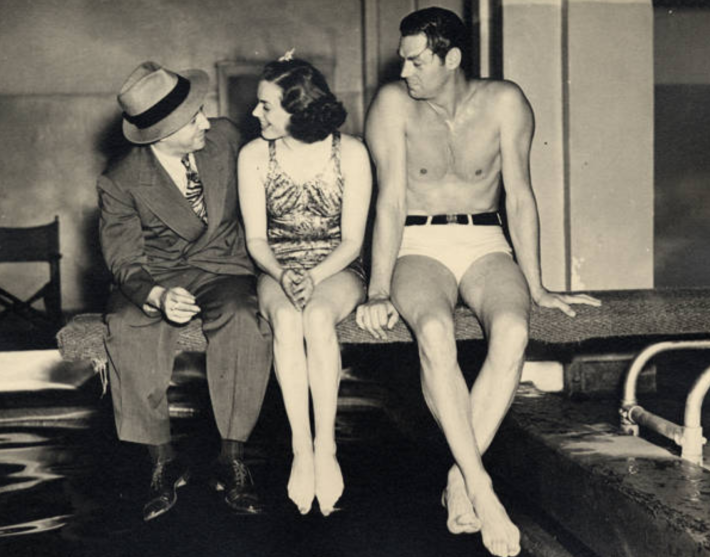When NFL Commissioner Roger Goodell, select fans, and certain highly touted prospects (although NOT Trevor Lawrence) mill around the grand stage of this year’s NFL Draft, they’ll be traveling in the footsteps of millions before them, including Tarzan, a serial killer, and President Franklin Roosevelt.
The city of Cleveland is pulling out all the stops to host what has become the signature event of the NFL offseason. Or at least, as many stops as they can as the nation emerges from a pandemic. The draft will be held outdoors, a concession to COVID-19, given that April on the lakefront in downtown Cleveland is a gamble.
A stage is currently under construction just east of the Browns’ stadium, within steps of the Rock and Roll Hall of Fame. The draft is being trumpeted as a chance to show things are getting back to normal—and as an economic opportunity for Northeast Ohio. “I believe this will help slingshot us out of COVID,” said David Gilbert, CEO of the Greater Cleveland Sports Commission, in an interview with Crain’s Cleveland Business.
Eighty-five years ago this month, construction was underway on that same part of the lakefront for another big-ticket event that, like the draft, was touted as an economic engine, a showcase for Cleveland—and a chance to have a party as the country tried to put cataclysm behind it.

For two summers in 1936 and 1937, the lakefront was full of exhibits, activities, and people at the Great Lakes Exposition, a World’s Fair in all but name. And now, as far as historians can tell, not a single trace of it remains onsite. It would be poetic to say the Commission and the NFL picked the site because of the historical connection. But it would be untrue.
“I wasn’t aware of it,” says Mike Mulhall, vice president of business development for the Greater Cleveland Sports Commission, the group that led the bid for the draft. “I’m not sure the people deciding even had that in mind.”
Not only has the Great Lakes Exposition generally faded from memory, but so too have the powerful companies that joined together with Cleveland officials to present it; the fame of many of the athletes and celebrities on hand to lend their star power; even the very bricks and girders that built it. The triumphs and scandals of the Expo are forgotten as the way of life that once made Cleveland a national power player and global destination.
World’s Fairs are designed to be impermanent; just not quite this ephemeral.
As spring dawned in 1936, things looked bleak in Cleveland as around the world. Franklin Roosevelt’s New Deal was putting some people back to work, but the Depression was still crushing millions. An embittered veteran named Adolf Hitler, who had become chancellor of Germany three years earlier, was remilitarizing his country. And Cleveland police—led by Eliot Ness, who became the city’s public safety director two years earlier, following his gangbusting exploits with the Untouchables in Chicago —were starting to think that the body parts that had been turning up around the city were all the work of the same killer.
In sum, it was a less than optimal time for the city of Cleveland to take a victory lap. But that’s what they were determined to do. The Great Lakes Exposition was held ostensibly to commemorate the centennial of the city, but the real reason was a little more mercenary.
“The main purpose was to try to bring people and money to Cleveland in the middle of the Depression,” says John Vacha, a Cleveland historian who wrote the seminal work on the Exposition, Meet Me On Lake Erie, Dearie!
When Cleveland Public Hall opened in 1922, it was the largest convention center in the world. The new building was part of the Group Plan of Neoclassical buildings downtown that included City Hall, the Board of Education Building, and a large open Mall, designed by noted urban planner Daniel Burnham. The new hall, along with hotels like the Statler, Cleveland, and Hollenden, led to Cleveland touting itself as the city of conventions.
And by that standard, 1936 was a banner year. For the second time in a dozen years, the Republicans held their convention in Cleveland. (It would be the last major party convention held in town until the Republicans returned to nominate Donald Trump in 2016—and the last major party convention anywhere where the nominee, Kansas Governor Alf Landon, didn’t even bother to show up.) Also that year in Cleveland were conventions for the Socialist Party, the American Legion, and the Townsend Plan, formed on the idea of an old-age pension and regarded as a significant and crucial voting bloc. (The featured speaker at the Townsend convention was Father Charles Coughlin, a Michigan priest who had already achieved some notoriety for his demagoguery on the radio.)
But they were just opening acts for the Great Lakes Exposition, which had all the feel of a World’s Fair—even if it didn’t land the official title.

London’s Great Exhibition in 1851 is regarded as the first World’s Fair, a large-scale gathering to show off the latest inventions and technological advancements of a world power still humming with the spirit of the Industrial Revolution. Every few years, a large fair would be held as a display of bragging rights; many of them in the United States, demonstrating the growing nation’s technical might and manpower. One in Philadelphia in 1876 celebrated the nation’s centennial; another in Chicago in 1893 honored the 400th anniversary of Christopher Columbus’s “discovery” of the Americas. Another, nine years later, was held in Buffalo, and is probably most notable for being the site of the assassination of President William McKinley.
The 1904 World’s Fair in St. Louis led to the OIympics being contested there (and the invention of the ice cream cone), and the 1915 World’s Fair in San Francisco was officially to celebrate the opening of the Panama Canal, but was functionally meant to show off the vibrancy of the city, rebuilt after the earthquake and fire of 1906. In 1928, representatives of 31 countries including the United States gathered in Paris and established the Bureau International des Expositions. The BIE would sanction, oversee, and designate official World’s Fairs, which would require years of planning and feature exhibitions from all over the globe.
The proposed fair in Cleveland had neither—and it appears to never have sought formal designation from the BIE. The idea of a fair to commemorate Cleveland’s centennial as a city were first discussed in 1935, and plans and construction moved at a breakneck pace. (By comparison, the NFL first announced Cleveland would host the 2021 NFL Draft way back in 2019.)
The plans for the Great Lakes Exposition were announced in November 1935, and ground was broken the following March. It took just 80 working days to transform the site from an industrial wasteland into what the Cleveland Plain Dealer promised would be “a fairyland.” Much of the land used for the Exposition was formerly landfill, leading Time magazine to refer to the Expo as “Fun on a Dump.” You could, entirely fairly, say the same about the Browns these days.
A bridge was constructed to connect the Mall to the lakefront. Not just any bridge; The Bridge of Presidents celebrated the Presidents from the Great Lakes states (and of course gave special attention to the eight who could claim Ohio as home). Workers from the Works Progress Administration planted horticultural gardens next to Cleveland Municipal Stadium, which had opened in 1931 as the largest stadium in America but was already dangerously close to being a white elephant.
The anchor tenant at Cleveland Stadium was supposed to be the Indians, but the team had used an out clause in its lease to return to its East Side home at League Park, which was much smaller—but kept the club’s expenses down. However, as part of the exhibition, the Indians played a game at Cleveland Stadium before more than 65,000 fans against the Yankees on Aug. 2, 1936. The game, probably most notable for a pregame demonstration by Cleveland’s highly-touted teen phenom Bob Feller, who’d made his major-league debut just two weeks earlier, was called due to darkness, tied at 4 after 16 innings.
The Porcelain Enamel Building would show off state-of-the-art construction, with decorative porcelain mounted on structural steel. The steel industry itself was a focal point of the exhibition, with an entire building devoted to “The Romance of Iron and Steel.” Transportation was another focus, with reproduction and original locomotives on loan from railroads, and models of long-gone cars once made in Cleveland—as well as White Autos, which continued to manufacture trucks and tractors, and offered a futuristic bus, their vision of what public transportation would be like in 1950.
The Streets of the World offered visitors a stereotypical trip around the globe, with tourists pulled through the streets in rickshaws (Cleveland in the ‘30s actually had a small but vibrant Chinatown on the East Side), listening to polka bands at the German Alpine Village, and eating fried chicken at Mammy’s Cabin.

Popular but morbid exhibitions—sort of a “Scared Straight” of its time—included the father of gangster John Dillinger, who had been gunned down two years earlier, wearing his son’s old suit talking about how crime doesn’t pay. There were also mock executions for visitors to enjoy.
Perhaps the most chilling display was the death mask of a man found by two children who had been playing hooky on the city’s East Side. Rather, they found his head; the body was found a short distance away the next day. It was the fifth dismembered murder victim to turn up within two years, and authorities suspected that the Cleveland Torso Murderer, also known as “the Mad Butcher of Kingsbury Run,” was responsible for all five and still at large.
In September 1934, the midsection of a woman believed to have been in her 30s, including the lower half of her torso and her thighs, had washed up on the Lake Erie shore east of Cleveland. Investigators found that the remains of “the Lady of the Lake,” whose identity was never discovered, had been treated with some kind of preservative.
A year later, teens in Kingsbury Run, a slum largely populated by transients and prostitutes, had discovered a man’s body, later identified through fingerprints as Edward Andrassy; his head and genitals had been cut off, and his body had been cleaned and drained of blood. While investigating the area, police found another man’s body, also with the head and genitals removed and also exsanguinated. This body, never identified, appeared to have been treated with the same chemicals used on the Lady of the Lake.
In February 1936, as plans were being made for the Expo, another body had turned up. Or rather, parts of one, wrapped in newspaper and stuffed in bushels near a factory on the city’s East Side. The victim, identified as Flo Polillo, had been decapitated as well.
On June 5, 1936—three weeks before the Great Lakes Exposition—the fifth victim had been discovered. In the canon of victims of the Cleveland Torso Murders, he would be known as the Tattooed Man. Investigators made a plaster cast of his face and diagrammed the tattoos on his body and displayed them at the Expo in efforts to identify the victim and hopefully catch the killer. It didn’t work, and in fact, two more dismembered bodies would turn up before the fair’s closure on Oct. 12.

The Expo’s first year was a success from the standpoint that millions did come to see it—even if it fell just shy of the goal of 4 million visitors. Its profitability was a little more murky. But organizers decided to return the following summer ... with one big change.
The Great Lakes Exposition could honor presidents and tout industrial accomplishments all the live-long day, but then as now, sex sells. Although Cleveland’s French population was limited, French culture in the Streets of the World was used as a foray into prurient interests, featuring scantily clad dancers in shows at the French restaurant, and a nudist colony that was, for all intents and purposes, a peep show.
The following year, Billy Rose’s Aquacade was added.
Its namesake was known for his unpleasantness, but Rose’s show was first-rate, featuring former Olympians Eleanor Holm and Johnny Weissmuller, who had become famous for playing Tarzan in movies. Weissmuller, nearly a decade removed from Olympic competition, retained some athletic prowess; he played in the 1937 Western Open, one of the most celebrated golf tournaments in the country, at nearby Canterbury Country Club.
Holm, whose drinking and partying during the transatlantic boat ride to the 1936 Games so scandalized American Olympic Committee President Avery Brundage that he removed her from the team, became even more infamous during that second summer in Cleveland. She and Billy Rose, both married to other people, embarked on a very public affair. By 1939, Rose’s Aquacade was at the New York World’s Fair, with Holm—then his wife—the star attraction. They remained married until 1954, when they split so acrimoniously that it was referred to in the press as “The War of the Roses.”

The second year of the Great Lakes Exposition (also something that a World’s Fair couldn’t do; the BIE decreed that fairs could last no longer than six months) started well, but almost a month of cold weather and rain during the summer tamped down attendance. The decision was made to keep the festival open past its scheduled Labor Day closing, and on the evening of Sept. 26, 1937, a solemn ceremony—including a bugler playing “Taps,” a band playing “Auld Lang Syne,” and the use of all the fireworks that for one reason or another hadn’t been fired off over the summer—saw off the Expo.
All told, another 3.5 million people came through the gates in 1937, though again, the financials are unclear. “Whether the fair made money was a little hazy,” Vacha says. “They weren’t supposed to make a profit, but the real profit was the money that was spent here and the jobs that it created.”
But the Great Lakes Exposition had become such a part of Cleveland’s physical and psychic landscape that Press columnist Winsor French said, “Cleveland, I think, is going to miss the Exposition far more than it realizes.”
World’s Fairs, by their nature, are supposed to be snapshots in time. The Great Lakes Exposition showed the industrial might (and fortuitous location, where the Cuyahoga River flows into Lake Erie) that had made Cleveland into one of the biggest cities in America.
But those events, perhaps like their host cities’ preeminence, are meant to be fleeting. Usually just a few buildings or monuments remain as signs of a summer of glory. The building housing the Buffalo History Museum began its life as the visitors center for the Pan-American Exposition. (Not far from it is a rock on a traffic island with a plaque noting the approximate location of President McKinley’s assassination.) The current Queens Museum was a pavilion used in the 1939 and 1964 World’s Fairs. And, contrary to what The Simpsons would have you believe, the Sunsphere is still standing in Knoxville (although technically, that was a BIE-sanctioned special exhibition, not a World’s Fair).
In Cleveland, the grand survivor was supposed to be the Horticultural Building, but after the fair it swiftly fell into disrepair. Nascent plans to recycle its steel frame were abruptly hastened when the building burned in a three-alarm fire on Dec. 22, 1941. (Ironically, it had been used recently for fire department training.) Clevelanders working downtown watched the fire and the Plain Dealer opined that “many Clevelanders, who considered the building an eyesore, did not regret its destruction.”
The site of the Expo reverted back to the landfill it once was. It was also where they found the last two victims of the Cleveland Torso Murderer. They were officially victims 11 and 12, although some investigators believed the actual tally could have been twice that, theorizing the killer rode the rails and committed similar dismemberment murders in Youngstown and Pittsburgh. And like all but two victims, they remained unidentified after being found in August 1938 in the Lake Shore Dump, within sight of Eliot Ness’s office in City Hall.
Two days after the bodies were found, Ness took the drastic step of a raid in Kingsbury Run. Dozens of people were arrested and the shantytown that had been built there was burned to the ground. Residents were aghast. But the murders stopped. The killer was never identified.
Much of the lakefront land east of East Ninth Street was redeveloped as Burke Lakefront Airport, a small airport serving private and charter jets—and a hot topic of debate for lakefront development in Cleveland. For decades, the lakefront downtown and near the river was seen as a venue for transportation, not recreation. But the massive Hulett unloaders no longer pull tons of iron ore from ship’s bellies for waiting railcars to deliver to steel mills, and city planners continue to grapple with how to best develop the lakefront for public use.

The biggest obstacle remains the railroad tracks that cut through the bluffs of downtown and the lake shore. The Bridge of Presidents was temporary, a proof of concept that a bridge could be built. At one point, Progressive Insurance founder Peter Lewis commissioned architect Frank Gehry for a new headquarters for the insurance company, to be built over the railroad tracks, spanning downtown and the Mall. But those plans never came to pass.
The land west of East Ninth Street that was home to the exhibition has now become North Coast Harbor. Public-private partnerships—like the one that brought the Exposition to fruition a half-century earlier—led to the construction of the Rock and Roll Hall of Fame (practically on the site of the Expo’s Firestone building, Vacha says) and the Great Lakes Science Center. The Rock Hall opened in 1995 with a massive concert Labor Day weekend at Cleveland Stadium. Once again, the baseball team was playing elsewhere, at a new stadium on the opposite end of East Ninth Street, and within a year, the Browns—who were still a decade away from existing when the Expo was held—would relocate to Baltimore. One of the conditions of Cleveland getting another NFL team was a new stadium, so one was built. Cleveland Stadium was bulldozed into the lake—as were the last remnants of the horticultural gardens, the only significant remains of the Great Lakes Exposition.
Traditionalists said any football in Cleveland should be played in the elements, but that decision effectively took the city out of the running to host a Super Bowl (it remains the only NFL city never to have played in or hosted one). But once the draft became a movable feast—and let’s be honest, until recently, the draft was the closest thing Browns fans had to a Super Bowl—Northeast Ohio had to have one.
Initially, Cleveland had proposed hosting the draft in 2019 or 2020—in conjunction with the Pro Football Hall of Fame in Canton, more than an hour’s drive down I-77. But a two-site draft was too much, even for the NFL. Ultimately, Cleveland was awarded the 2021 draft. Mulhall said initial plans were to place the stage on a barge floating in the lake—not far from where Billy Rose’s Aquacade was located—before settling on the lakefront property.
“Make no little plans,” exhorted Daniel Burnham in a quote that’s become a cliché. “They have no magic to stir men’s blood.” Cities are littered with stunning, enormous buildings that exist only on paper. But Cleveland was able to do it once, in a hurry and while mired in the depths of the Depression—so hosting the NFL Draft should be child’s play by comparison.
Even if it is just temporary.






